Renovating leucaena pastures to maintain productivity – the north Queensland perspective
Leucaena pastures are the most productive option in the dry tropics but require careful management to ensure the benefits are maintained. The CQ pasture team is renovating old leucaena paddocks at Brian Pastures Research Facility and on a similar theme, the North Queensland Pasture Resilience Project team provide an update on ‘re-lifing’ leucaena and pasture at Pinnarendi near Mt Garnet in north Queensland.
The cattle are back
For the first time since September 2022, cattle are grazing in the leucaena paddocks at Pinnarendi as part of a DPI/MLA grazing experiment running since 2017. Thirty-seven head of mainly heifers (avg. 296 kg) were weighed in on 13 June 2025 and are being grazed in two groups. One group is in paddocks with wide-spaced (20 m) leucaena with the other group in paddocks with the original row spacing (10 m). The aim is to monitor cattle weight gain, stocking and changes in pasture productivity and diet quality with regard to the management required (mainly pruning) to maintain the two systems. As pointed out in the Brian Pastures article, leucaena pruning to maintain good grazing height is a significant management imposition and a deterrent to producers adopting leucaena. Can wider leucaena spacings offer similar animal productivity whilst reducing management headaches and costs?
Leucaena – productive and profitable at Pinnarendi
The leucaena at Pinnarendi was planted in 2017 when the new Redlands cultivar became available. The aim was to compare the productivity (liveweight gain) of the psyllid tolerant Redlands with the industry standard Wondergraze in a psyllid prone environment – the thinking was that Redlands should demonstrate higher productivity since Wondergraze would periodically be afflicted with psyllid infestations.
Redlands and Wondergraze were originally established in single-rows at 10 m spacing in eight replicated paddocks at the 62 ha site. The existing inter-row pasture was retained comprising a mixture of native and improved species (mainly black spear, Indian couch, sabi and Rhodes grasses, plus stylo and Wynn cassia). Grazing started in April 2018 – 14 months after leucaena planting. After nearly four years and three cohorts of steers, the productivity of animals was the same whether they were grazing Redlands or Wondergraze. Remarkably there were no prolonged psyllid infestations at the site over this period, except for a couple of months during the establishment phase. Whilst this result was frustrating, the trial did confirm the potential that Redlands offered to the region – average measured annual liveweight gain was 222 kg (0.61 kg/day) at stocking rates around 1.7 ha/AE – representing a 3 fold increase in productivity compared to native pastures and access to more profitable markets. More information on the Pinnarendi trial and profitability benefits of leucaena, can be found in an economic analysis and case study recently completed under the Queensland Pasture Resilience Program (Economic Evaluation of Leucaena at Pinnarendi Station – FutureBeef).
So why do we need to renovate?
While the Pinnarendi results confirmed the performance of Redlands and demonstrated the high productivity of leucaena, issues did emerge at the site. Set stocking of the paddocks under the experimental grazing regime led to the inter-row pasture becoming degraded with an increase in weeds, decline in 3-P species and dominance of the less desirable wynn cassia. It was apparent that the balance between leucaena and pasture needed further investigation. Early adopters of leucaena in the region were also grappling with this issue – with some producers adopting wider row spacings for new leucaena plantings to ensure greater pasture yields. The problem is two-fold: leucaena grows rapidly during the summer wet season which is also the time that cattle prefer to eat the pasture grasses (consuming more legume later on as the pasture nutrition declines) so leucaena is underutilised and grows tall; secondly, the capacity to run high stocking rates from the supply of high quality leucaena leaf in the dry season also results in higher utilisation of inter-row pasture.
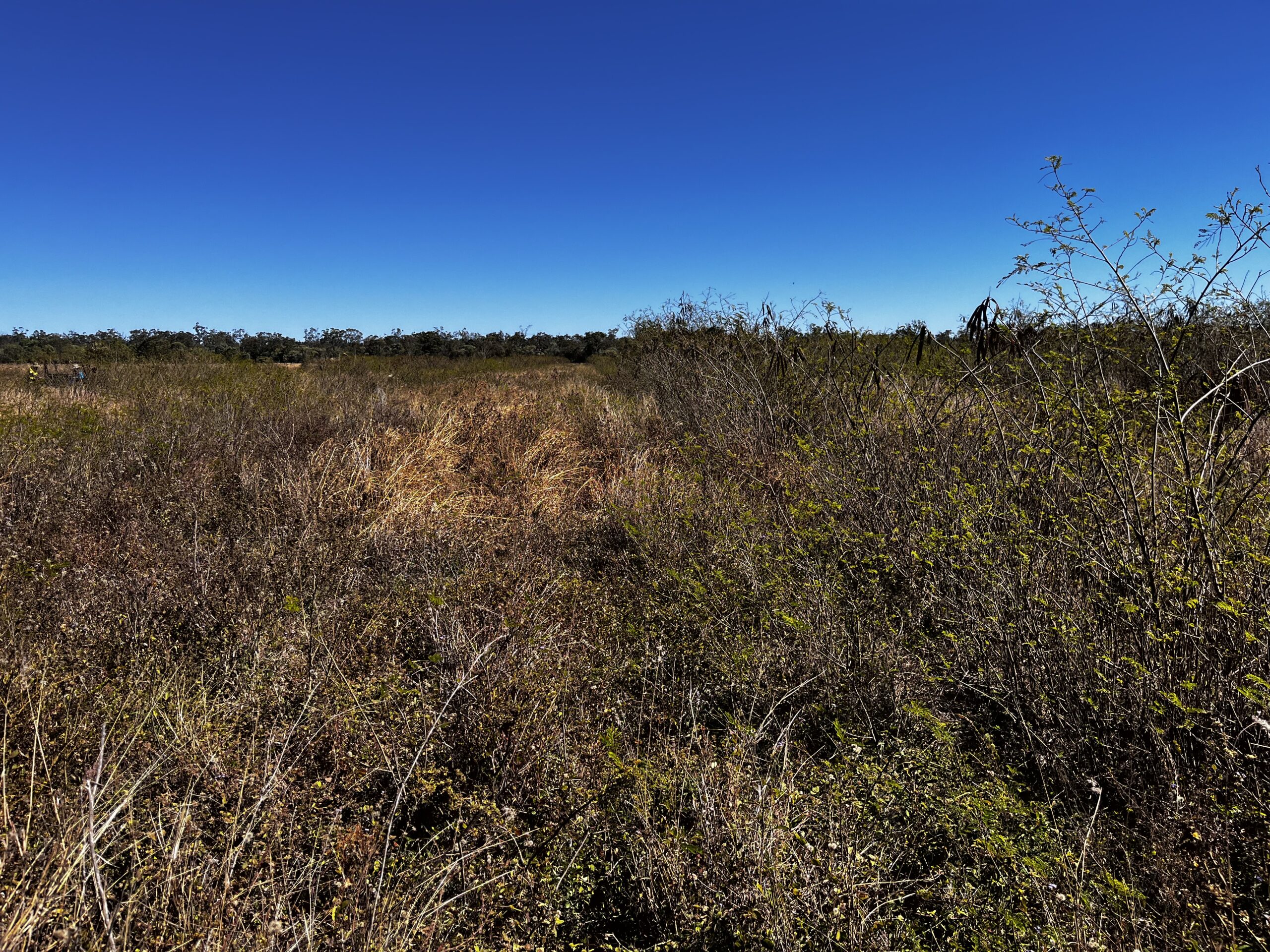
At Pinnarendi, leucaena needed pruning after five years. After removal of the third cohort of trial steers in August 2021, all rows in all paddocks were mulched (following rain) to about 30 cm using a 200 HP Valtra tractor with a forestry mulcher taking about 11 hours. Leucaena regrew over the 2020-21 wet season after which a cohort of 30 heavyweight steers were grazed for 4 ½ months – impressively they gained 103 kg (0.75 kg/day). At this time the project was wound-up and the site was handed back to the owners.
The eight paddocks were then grazed informally, mostly rotating a cow/calf herd or steers through the paddocks at moderate stocking rates. Leucaena was cut again (slashed) in the 2022-23 wet season and was mostly kept to less than 3 m. However, the inter-row pasture did not improve and thickets of volunteer leucaena progressively became established – likely a result of seed dispersal from mulching in 2020. This was notably worse in the Wondergraze paddocks.
A new approach
There was always an intention to re-use the Pinnarendi site within the Queensland Pasture Resilience Program with a proposal to compare set-stocked and rotational grazing systems and the effect on cattle growth, pasture composition and productivity. Pasture composition and yield (Botanal) were measured in June 2024 confirming the poor condition of the inter-row pasture. The pastures were very weedy with a low frequency of 3P grasses: only 36% and 22% for the Redlands and Wondergraze paddocks, respectively. Common weeds included Sida, Ageratum, Amaranthus and Mitracarpus along with annual grasses and as mentioned, there were thickets of volunteer leucaena in many areas (up to 3 m tall).
Following discussions with the owners and concerns about interrow leucaena continuing to thicken (requiring management) a new approach was developed. This was to change row spacing and pruning management and adopt spell grazing across the whole site whilst monitoring the inter-row pasture and grass/leucaena balance. Given the poor condition of the inter-rows, and the likelihood of remaining 3P grasses being grazed heavily at the high stocking rates sustained by leucaena, it was resolved to renovate the inter-rows by sowing new pasture. Additionally, two revised replicated treatments were proposed:
(1) removing every second row of leucaena to increase grazing pressure on leucaena with pruning as required to manage excess growth based on monitoring (should it be needed)
(2) maintaining existing leucaena row spacing with more regular but higher pruning to control excess leucaena growth (say, every 2 years, or yearly).
Renovating leucaena and pasture at Pinnarendi (2024-25)
It was decided to renovate the site over two years (four paddocks per year) beginning in the 2024-25 wet season. Paddocks with the wide-spaced leucaena treatment were renovated initially. Alternate leucaena rows were mechanically mulched (mulcher on skid-steer loader) to ground level in early Dec 2024 – including any areas with inter-row thickets. These paddocks were then worked with a disc plough, storm rain having provided moisture for working. This rain also stimulated regrowth of the mulched leucaena which was sprayed (triclopyr+picloram at label rates) using a buggy and hand-lance when it was about 40-80 cm high (late December to early January). This took about half a day per 7 ha paddock. Persistent rain ensued, causing heavy regrowth of weeds in the disced areas. This prompted a herbicide application using glyphosate at label rates in late January with a good kill achieved. Around the same time, leucaena in the rows which were to be retained was pruned to about 80 cm using a 3-point hitch mounted boom mulcher – we tried to go higher but the leucaena laid over and would not cut properly. There was more persistent rain and the tractor wasn’t back in the paddocks until mid-February allowing a light re-discing to kill remaining weeds and incorporate fertiliser (DAPS at 188 kg/ha) which had been broadcast few days before.
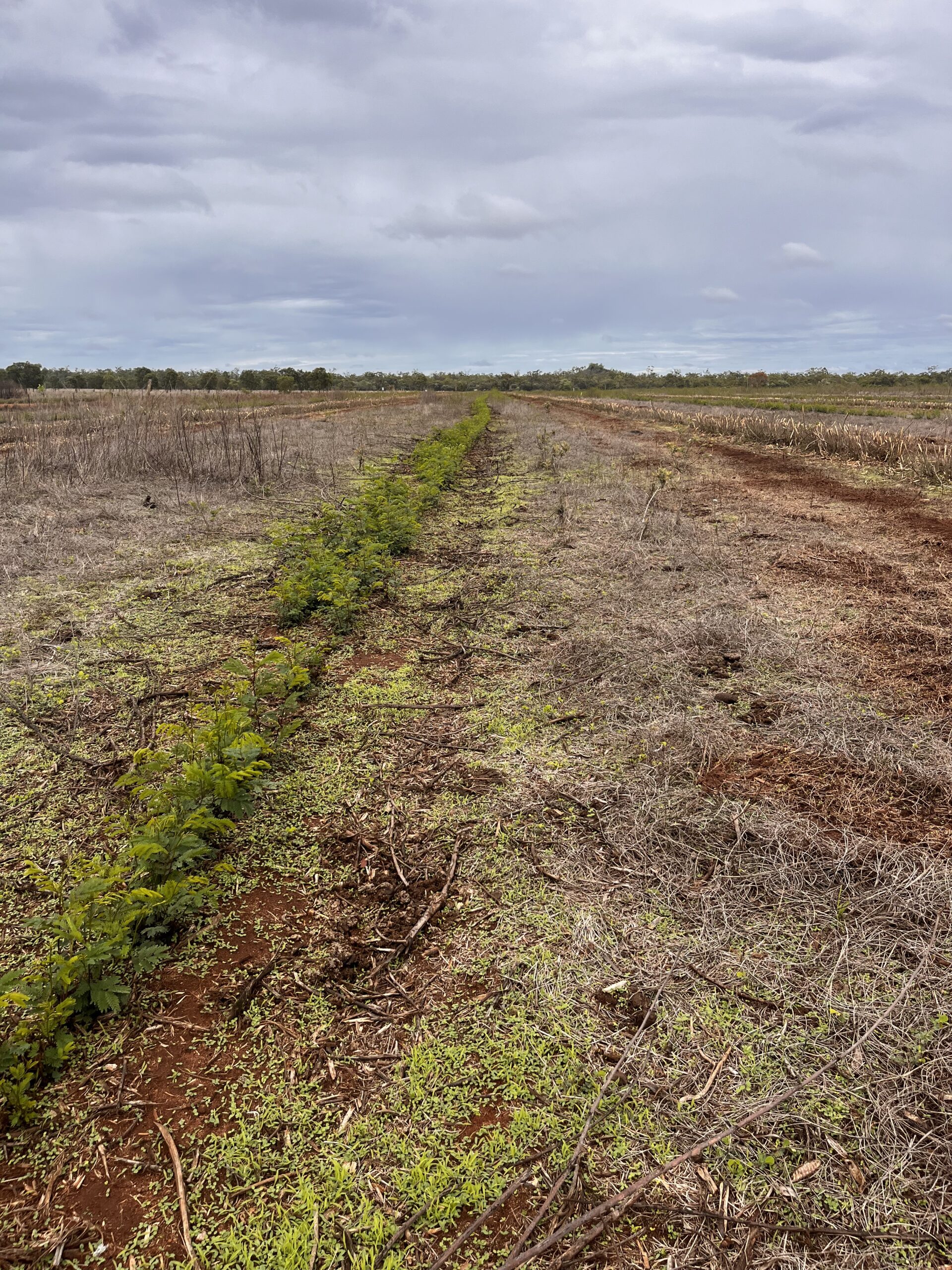
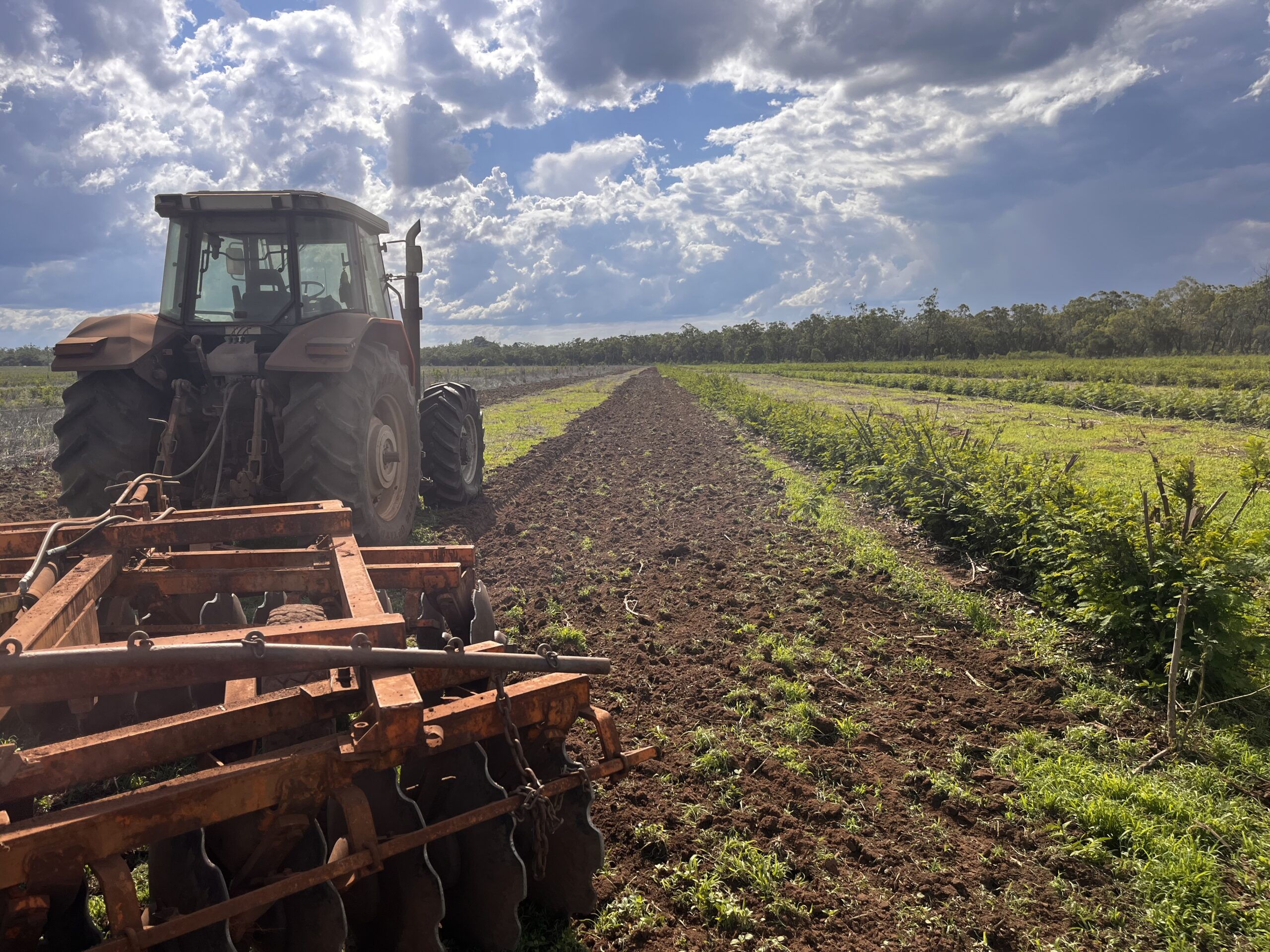
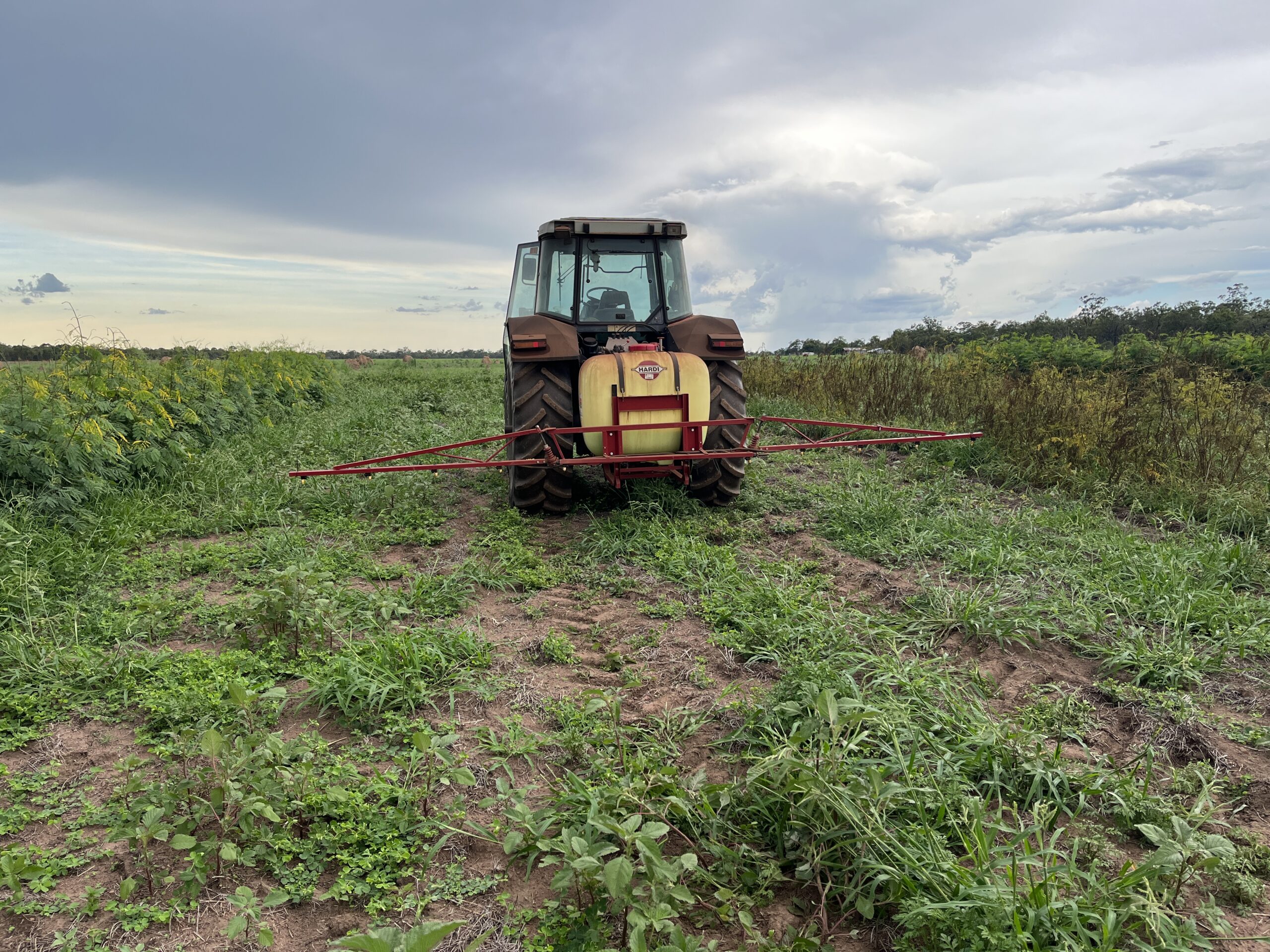
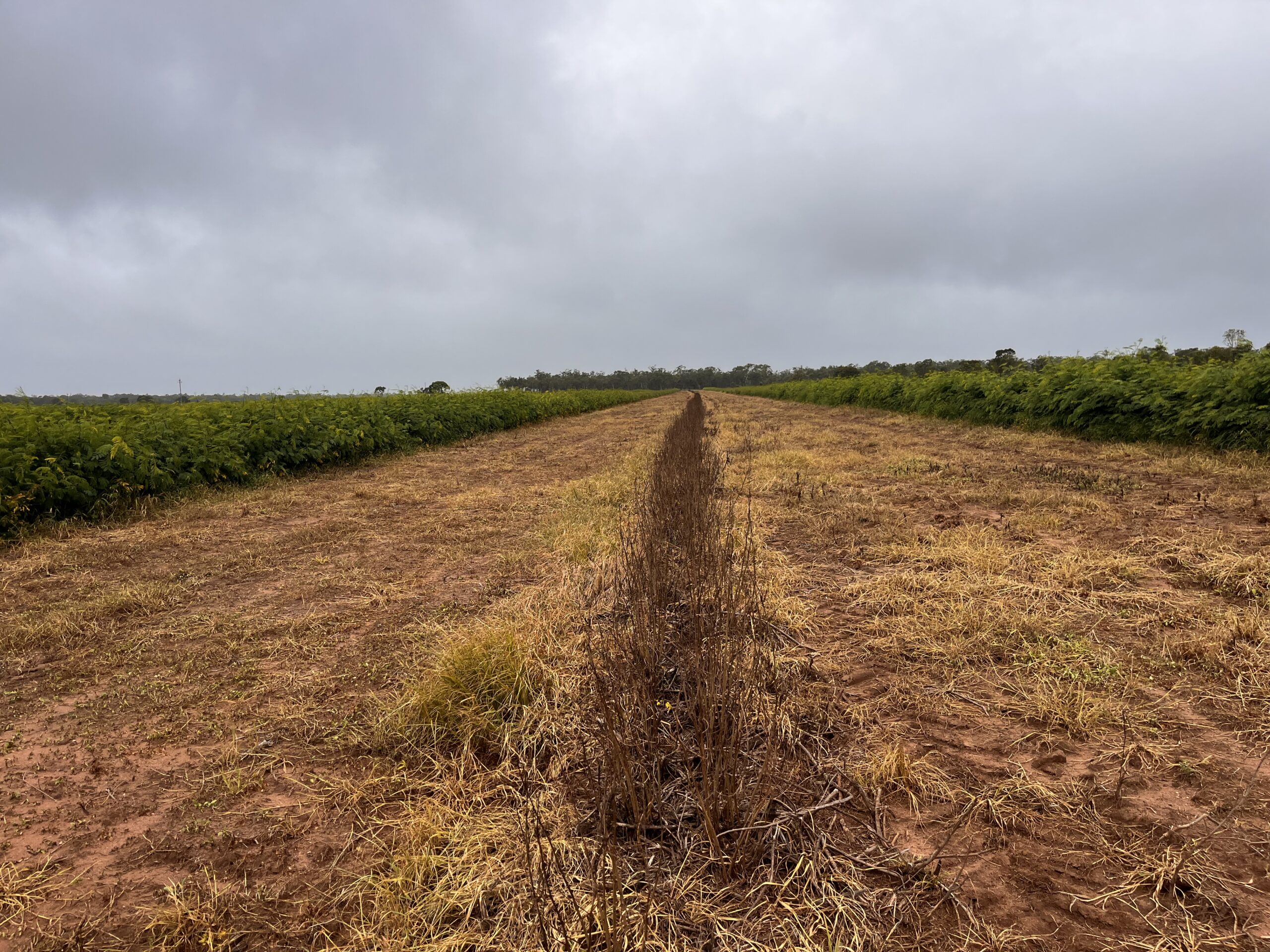
The paddocks were now ready for re-seeding. Over three days (19-21 February), a mixture of grasses (signal, Callide Rhodes and coated creeping blue) were broadcast onto the cultivated areas using a buggy-mounted spreader. The sown areas were rolled with a Cambridge roller immediately afterwards to ensure good seed-soil contact. This timing was later in the season than ideal. There was no rain for about 10 days but fortuitously good falls were received through March into April.
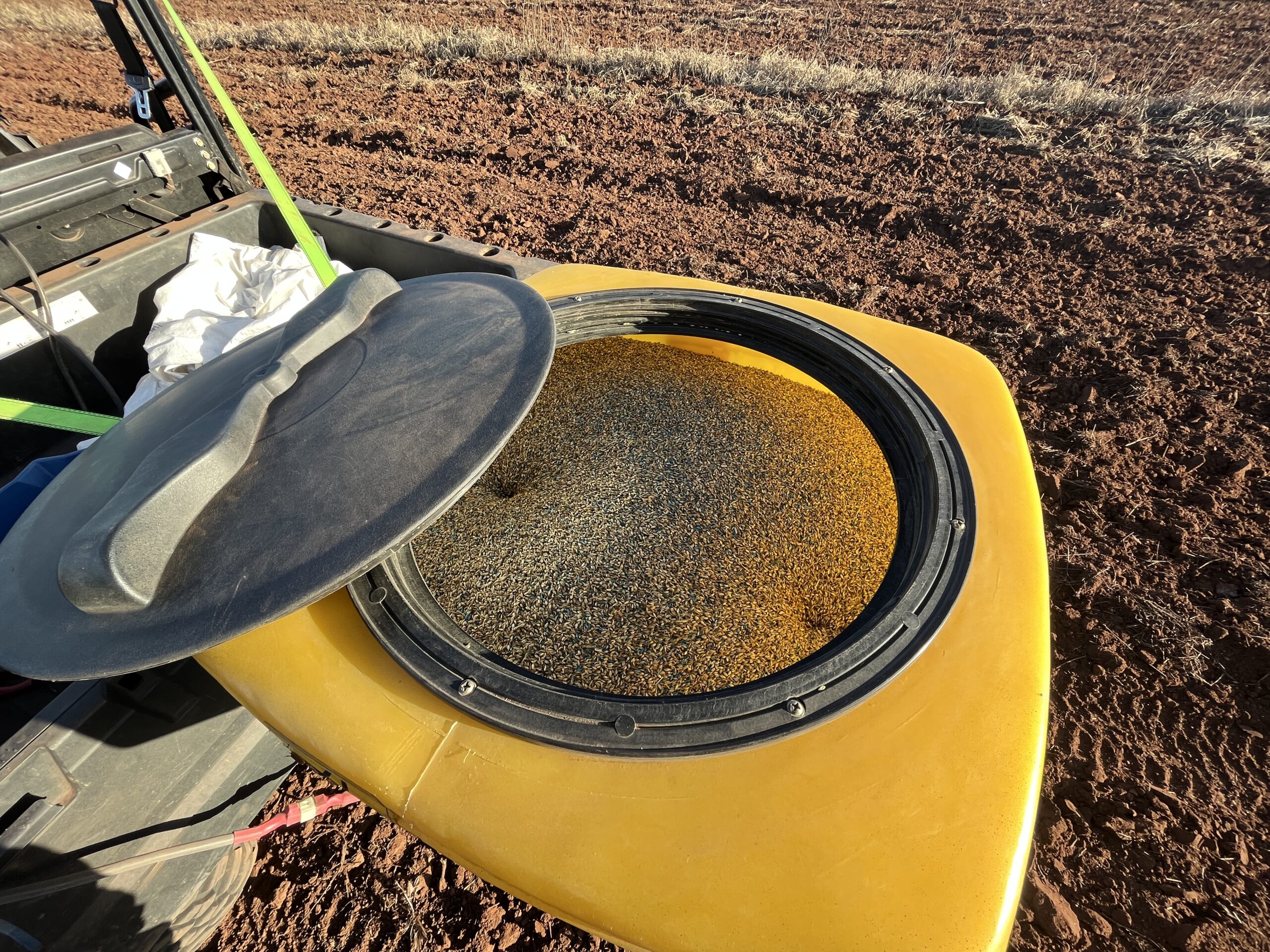
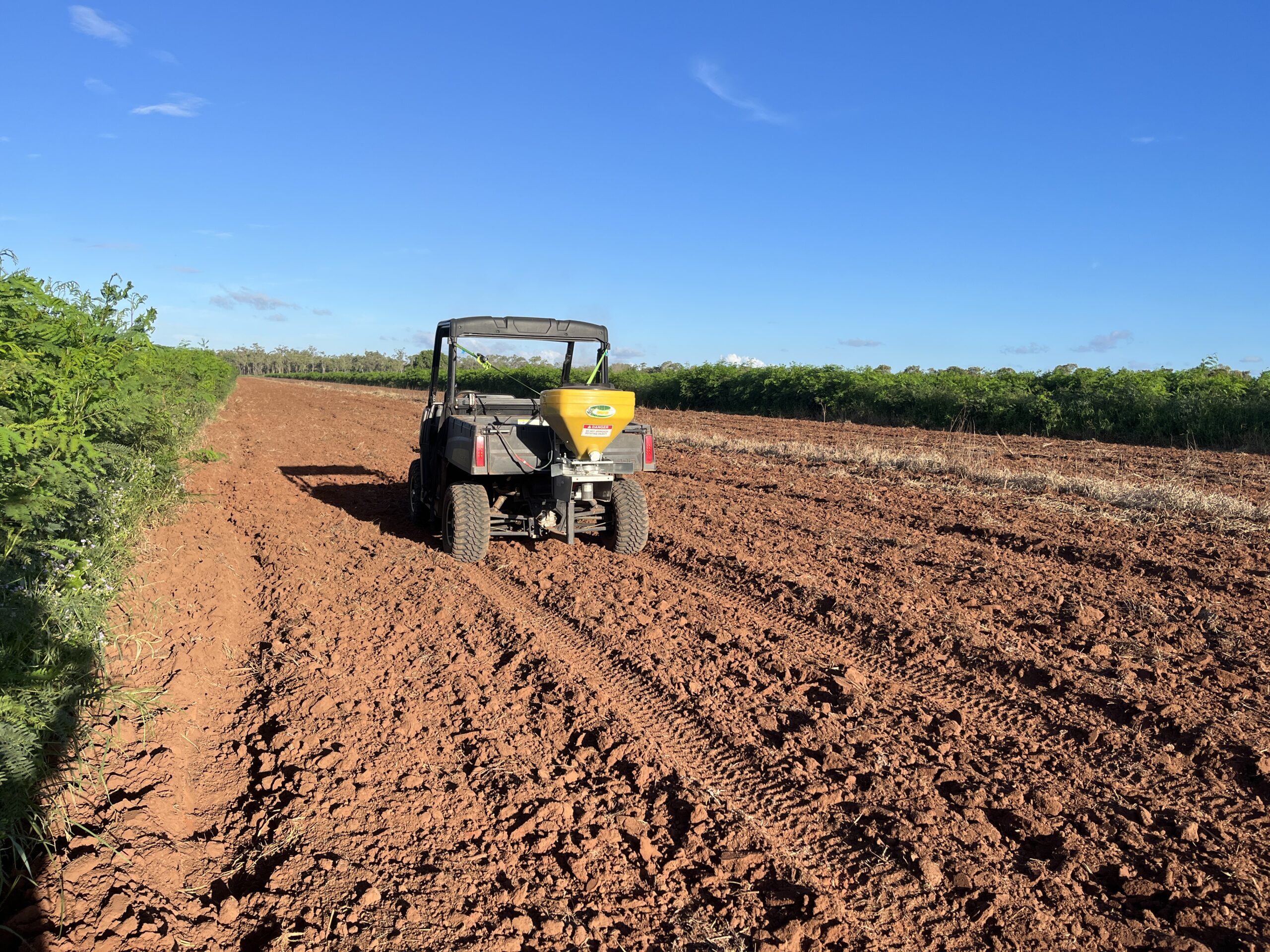
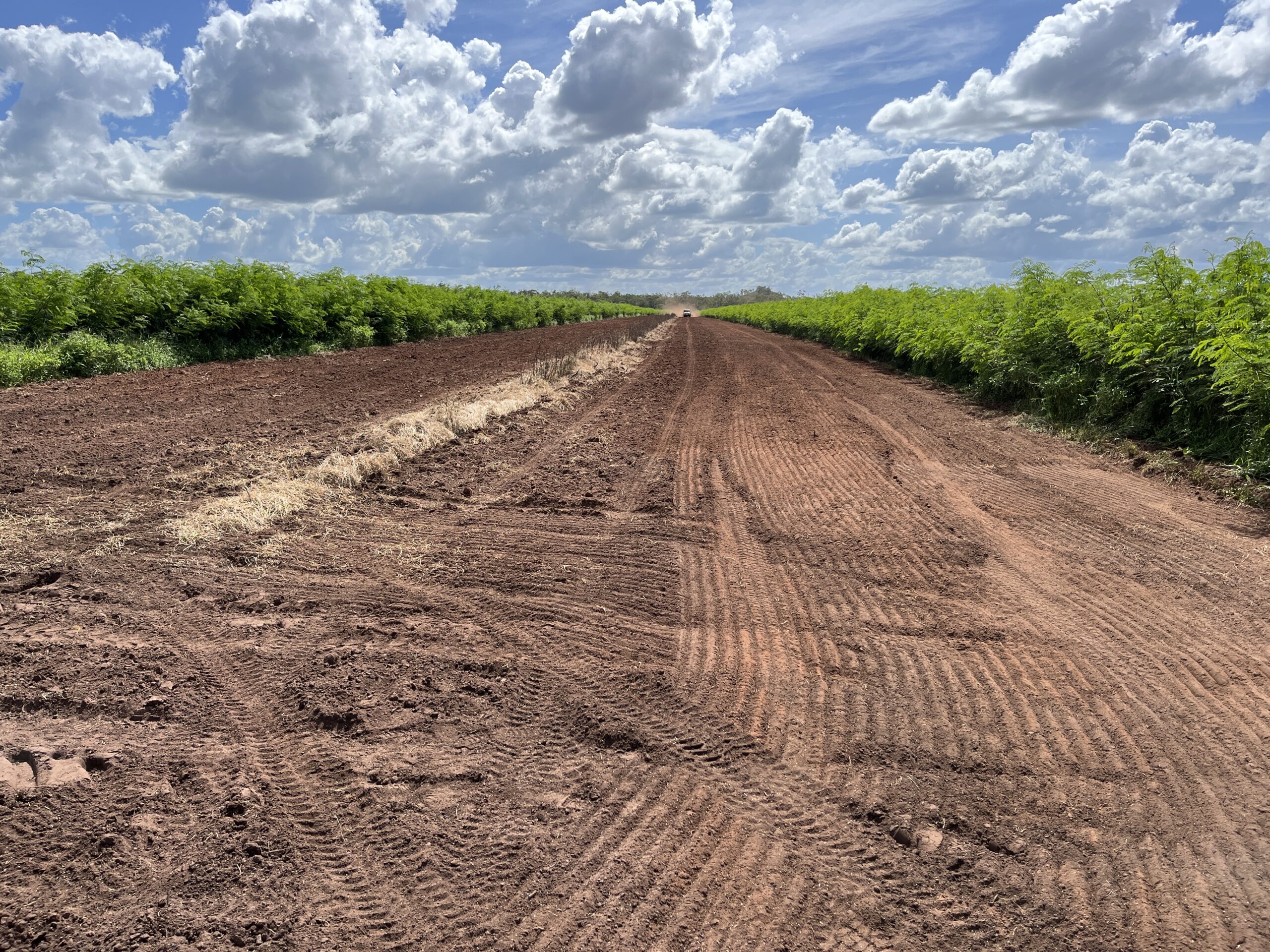
Broadleaved weeds (mainly white eye, needle burr) were controlled using selective herbicide (fluroxypyr at label rates) immediately before Easter. This also controlled volunteer leucaena which had survived two cultivations and a glyphosate application! It also controlled any re-shooting leucaena in the removed rows, some of which was persisting after mulching and herbicide.
There was excellent establishment of Callide and sabi grass, but lower populations of creeping bluegrass (despite lifting sowing rates to compensate for low seed viability – a good lesson there). An extended wet season resulted in rapid growth of both the grass and leucaena, although psyllids extensively damaged the Wondergraze between June and August. By the time the cattle were introduced into the paddock, the Rhodes grass had seeded and the pasture yield in the inter-rows was in the order of 4 tonne of dry matter per hectare.
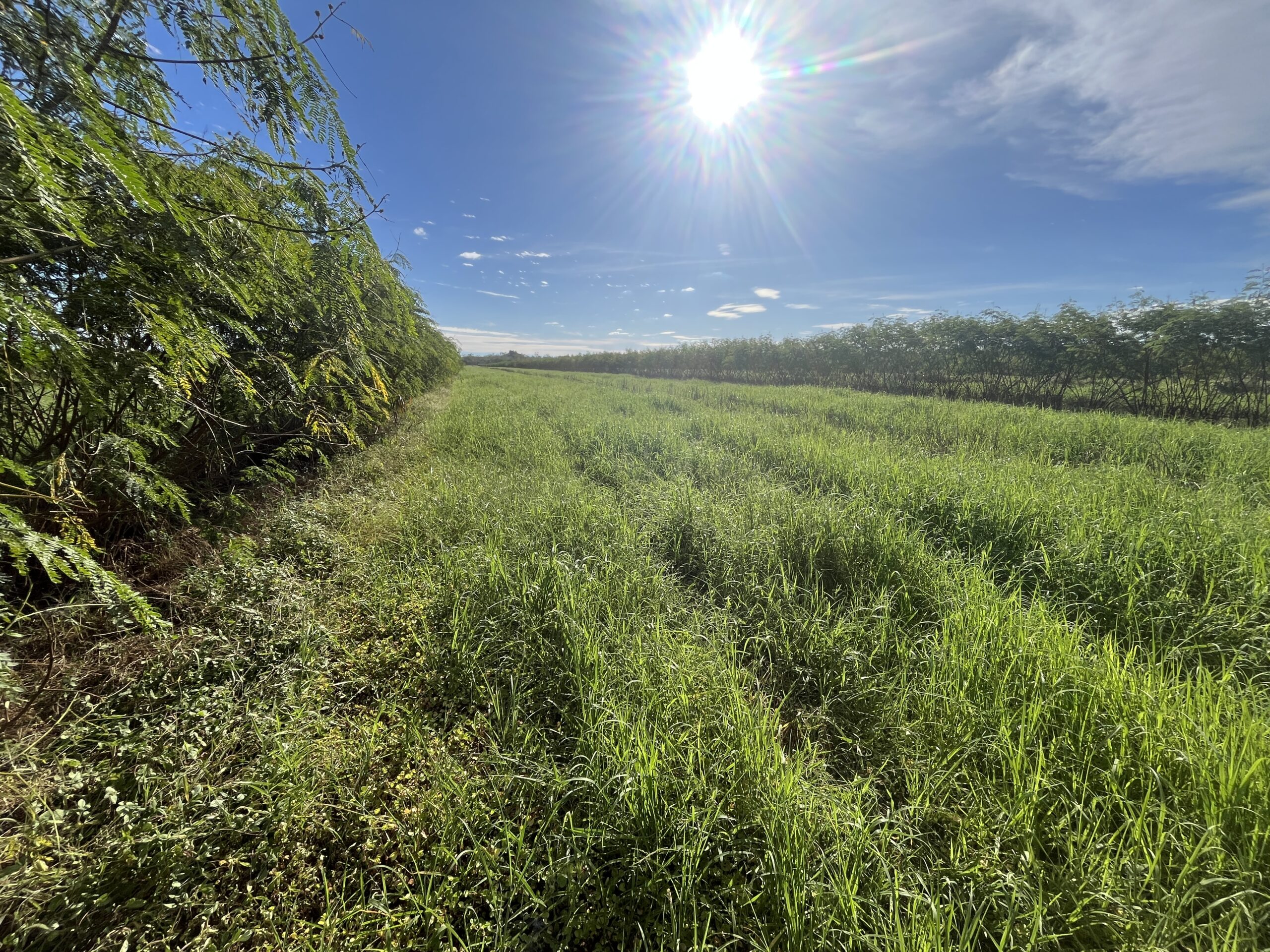
Grazing and onwards
Cattle from Pinnarendi were weighed on 13 June and allocated evenly to two mobs. They are being rotationally grazed moving every 2-3 weeks within their respective four paddocks so that paddocks get a 6-9 week spell. They were re-weighed on 11 August with both groups averaging 0.5 kg/hd/day over the first eight weeks. Cattle in the renovated treatment did not demonstrate an advantage despite having the new inter-row pasture. This is attributed to the low stocking rates used during the establishment phase, whereby all animals received adequate nutrition for growth. Typically for this time of year, cattle have hammered the leucaena, moving directly to leucaena rows when entering fresh paddocks. Faecal sampling for diet quality has been done monthly and as for the previous experiment at Pinnarendi is expected to show leucaena consumed as a high proportion of the diet.
Pasture composition and yield will be measured using the Botanal method at the end of the dry season (October-November). Plans are in-place to renovate the other four paddocks during the upcoming wet season using the same approach – however this time all leucaena will be retained!
This work is conducted under the Queensland Pasture Resilience Program which is a partnership between the Department of Primary Industries, Meat & Livestock Australia and the Australian Government through the MLA Donor Company.